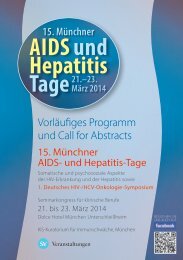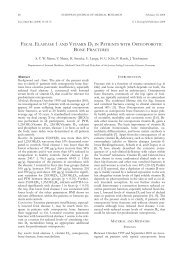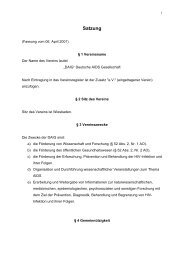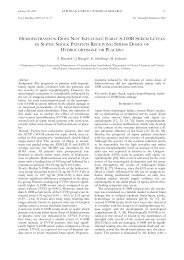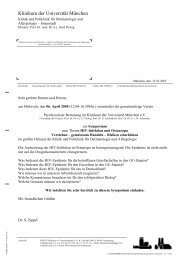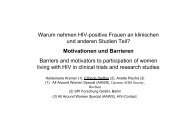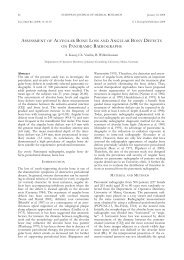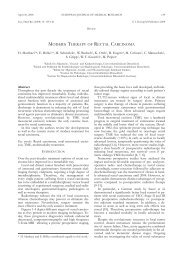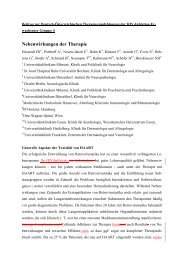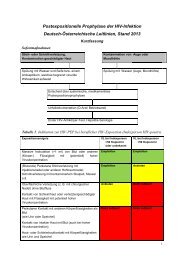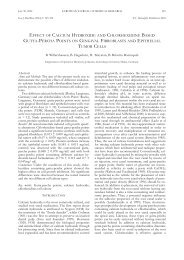European Journal of Medical Research - Deutsche AIDS ...
European Journal of Medical Research - Deutsche AIDS ...
European Journal of Medical Research - Deutsche AIDS ...
Create successful ePaper yourself
Turn your PDF publications into a flip-book with our unique Google optimized e-Paper software.
June 27, 2007 EUROPEAN JOURNAL OF MEDICAL RESEARCH<br />
65<br />
B.32 (Vortrag)<br />
Clinical correlates and consequences <strong>of</strong> discordant<br />
immuno-/virological response in patients initiating<br />
HAART at severe immunodeficiency<br />
Kreuzberg C. 1 , Lüchters G. 2 , Hertling S. 3 , Degen O. 3 ,<br />
van Lunzen J. 3<br />
1 Universitätsklinikum Hamburg Eppendorf, Medizinische<br />
Klinik I/Ambulanzzentrum Infektiologie, Hamburg, Germany,<br />
2 Universität Bonn, Bonn, Germany, 3Universitätsklinikum<br />
Hamburg Eppendorf, Ambulanzzentrum Infektiologie,<br />
Hamburg, Germany<br />
Background: Discordant immuno-/virological response has<br />
been described in HIV infected patients following initiation <strong>of</strong><br />
HAART. However, the clinical consequences <strong>of</strong> such discordant<br />
response remain to be elucidated especially in patients<br />
starting HAART in advanced stages <strong>of</strong> immunodeficiency.<br />
Methods: A cohort <strong>of</strong> 39 HAART naive patients with severe<br />
immunodeficiency (CD4 counts before start <strong>of</strong> HAART < 100<br />
cells/�l) but adequate antiviral treatment response (sustained virological<br />
suppression <br />
200 cells/�l on two subsequent occasions) after 1 and 2 years <strong>of</strong><br />
HAART versus those with discordant response (suppressed viral<br />
load but no rise in CD4 > 200 cells/�l).<br />
Results: At initiation <strong>of</strong> HAART 30/39 (76,9%) <strong>of</strong> the patients<br />
had at least one <strong>AIDS</strong> defining diagnosis. One third <strong>of</strong> the patients<br />
(12/39) developed a rise in CD4 count to > 200 cells/�l<br />
in the first year <strong>of</strong> therapy. There was no difference in mean<br />
initial CD4 counts and viral load (49 versus 28 CD4 cells/�l<br />
and 5,5 versus 5,6 log HIV RNA copies/ml) in patients with or<br />
without immunreconstitution after year one. Five patients<br />
(12,8%) experienced at least one <strong>AIDS</strong> defining event during<br />
the first year <strong>of</strong> HAART, 4(80 %) <strong>of</strong> the events occurred in the<br />
discordant group. The overall incidence rate was higher (5/148<br />
versus 1/71,5 person years) in this group. In the second year <strong>of</strong><br />
HAART 26 (66,7%) reached CD4 counts above 200 cells/�l.<br />
Again mean CD4 counts and viral loads at initiation <strong>of</strong><br />
HAART (39 versus 25; 5,6 versus 5,2log) did not differ clinically<br />
significantly. Interestingly the overall incidence <strong>of</strong> <strong>AIDS</strong><br />
defining events in long-term discordant patients was even lower<br />
(0/ 72,5 versus 6/146 person years).<br />
Conclusion: Severely immunocompromised patients with<br />
discordant immuno-/virological response are at special risk to<br />
develop disease progression in the first year after initiating<br />
HAART but not thereafter. Long term inadequate rise in CD4<br />
count does not seem to have clinical relevance in patients with<br />
sustained viral suppression.<br />
B.33 (Poster)<br />
CD4 cell count at initiation <strong>of</strong> HAART over time -<br />
An approach by using German ClinSurv<br />
multicenter cohort data<br />
Kollan C. 1 , Kühne A.1, Hamouda O. 1 , for the ClinSurv<br />
Study Group<br />
1 Robert Koch Institut, Infektionsepidemiologie, Berlin, Germany<br />
Objectives: Since introducing HAART the “philosophy”<br />
when to initiate therapy changed several times. The “hit ear-<br />
ly” era was followed by the paradigm to start late which<br />
meant at CD4 levels £200. The optimal time point to begin<br />
ART is still uncertain. This study aims to highlight the actual<br />
clinical reality in Germany in the past 10 years. Comparsion<br />
<strong>of</strong> CD4-counts at ART onset in 21 HIV treatment centres between<br />
1997 and 2006.<br />
Methods: Analysis <strong>of</strong> CD4 counts at start <strong>of</strong> first-line ART<br />
by period <strong>of</strong> clinical observation. CD4 values closest to startdate<br />
were chosen in a range <strong>of</strong> 30 days before and 10 days after<br />
initial treatment. Patients where stratified into: (a) having<br />
been observed >45 days before ART and (b) £45 days <strong>of</strong> observation.<br />
CD4 counts were compared by the Kruskall-Wallis<br />
test.<br />
Results: 1.552 patients were eligible, 578 for (a) and 974 for<br />
(b). The trend over time <strong>of</strong> median CD4 counts for both<br />
groups show a parallel course with a peak in the year 1998,<br />
438 and 224 for (a) and (b) and a minimum in 2000, 93 and<br />
221 for (a) and (b) respectively. The overall median is 171<br />
and group medians are 252 (a) and 105 (b) (p



